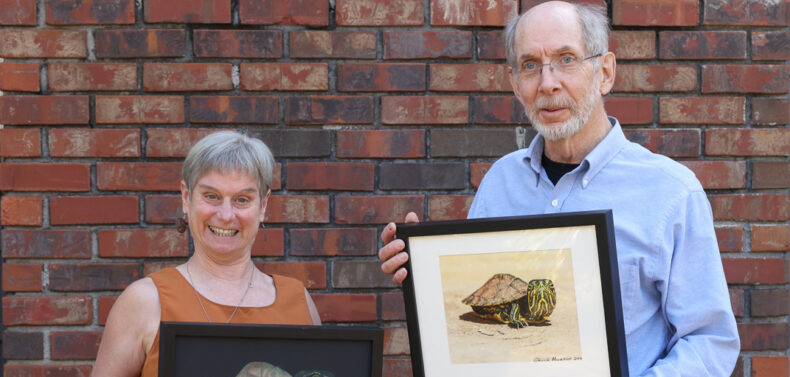With a headstrong determination to fully recover from a stroke, Babs McDonald turned to the healing art of painting as a therapeutic modality. “Camera and Canvas,” an exhibition she created in collaboration with wildlife photographer Chuck Murphy, opens this weekend at the State Botanical Garden of Georgia. Her paintings demonstrate firsthand that individuals in recovery can accomplish much more than they might be led to believe.
In 2017, McDonald experienced an ischemic stroke affecting her dominant left side. Following the stroke, she was told by neurologists that she would not improve after three months, and was later told 18 months after she continued to improve. Rejecting such a discouraging prognosis, she switched to seeing a neurologist at Emory University Neurology Clinic for a second opinion.
One year post-stroke, her left hand was still mostly curled into a loose fist, her wrist was immobile, and big arm movements were difficult. Growing restless with inactivity, she mentioned to her new neurologist that she was thinking about picking up painting as a fun way to pass time. He strongly suggested that she use her left hand to paint as a form of therapy. Since beginning painting, her wrist has almost fully recovered, and she has much better fine motor control.
“After my traditional therapy ended, I began exploring other therapeutic approaches, and I have tried over 35 therapies, most of which have moved my recovery forward in one way or another,” says McDonald. “My personal trainer works with me on strength, balance and cardio, all of which contribute in important ways to support my painting, as surprising as that may seem. My rolfer [a type of massage] has provided therapy to support fine motor movement. Therapy, like everything organic, is interconnected, and it all contributes to recovery. Some of the ways painting is unique is that I paint almost every day—repetition is a key to recovery—and I gain an incredible amount of satisfaction and pleasure from painting. Painting for me is a tangible sign of my progress.”

Initially, McDonald approached the challenge of painting with a “big pointillism” technique of dabbing paint on paper, and eventually began experimenting with various media to push the boundaries of her physical limitations. As her wrist became more mobile, she was able to pick up a paint brush and give more advanced techniques a go.
Born with a love for animals and nature, she reached out to longtime friend and fellow artist Chuck Murphy to ask if she could use one of his wildlife photographs as a reference. He readily agreed, and by the second collaborative painting, Murphy suggested the idea of presenting an exhibition together.
No stranger to the State Botanical Garden, Murphy has had three prior exhibitions in the Visitors Center gallery and has another booked for January 2025. After retiring from a career in software development in 2007, he became more focused on pursuing nature photography. In addition to having his photographs on view at The Georgia Museum of Art, Lyndon House Arts Center and Oconee Cultural Arts Foundation, he’s taught photography courses for OLLI@UGA, UGA Continuing Education and the State Botanical Garden.
A synergetic endeavor, the exhibition “Camera and Canvas” consists of 20 pairs of images: a photograph by Murphy accompanied by a painting by McDonald. Through this collection of paintings, McDonald aims to connect people to other animals by emphasizing the animal’s eyes. Pairs are arranged chronologically so that viewers can not only observe the refinement of McDonald’s artistic development, but reflect on her progression towards recovery as well. Accompanying labels describe her experience behind creating each painting.
“Aside from feeling a connection to animals in general, I hope people will learn that recovery from stroke is possible,” says McDonald. “More specifically, I hope my work demonstrates the therapeutic potential of art. Although every stroke is different, people who have experienced a stroke are told by the health care community that their recovery is limited—by time and by the stroke’s severity. I refused to accept that, and six years later, I still improve a little every day. Stroke recovery is slow to be sure, but if I feel joy at every small step forward, I get to feel that joy every day. I plan to completely recover. I am willing to be patient and keep working on recovery.”
An opening reception for “Camera and Canvas” will be held Sunday, July 9 from 2–4 p.m., and the exhibition will remain on view through Aug. 12. McDonald will offer an artist talk and Q&A about her experience at 2:30 p.m., and Condor Chocolates will provide white and dark chocolates to pair with wine. Signed and numbered prints will be available to purchase, while McDonald’s originals will be donated to Emory University Hospital’s neurology floor, where she hopes they will inspire patients, families and health care workers.
Like what you just read? Support Flagpole by making a donation today. Every dollar you give helps fund our ongoing mission to provide Athens with quality, independent journalism.










